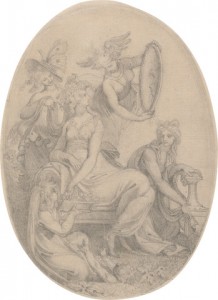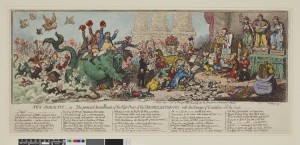
Henry Fuseli, Drawing for the Frontispiece of Erasmus Darwin’s “The Botanic Garden.” Alternate Title: Flora Attired by the Elements. Graphite on slightly textured, cream laid paper. Sheet (sight): 8 3/4 x 6 3/8 inches (22.2 x 16.2 cm). Inscribed on back in graphite: “Fuseli evidently drew this and A. Smith engraved it / The engraving being published June 1st 1791 by J. Johnson. / St. Pauls Churchyard.” Watermark: Britannia. Yale Center for British Art, Gift of Lowell Libson. B2007.2
A Digest of “‘Mere Matter’: Causality, Subjectivity and Aesthetic Form in Erasmus Darwin.” Romanticism and Victorianism on the Net. No. 56 (2009). <http://www.erudit.org/revue/ravon/2009/v/n56/1001100ar.html>.
Allison Dushane, University of Arizona
In his two-part medical treatise Zoonomia (1794-1796), Erasmus Darwin—physician, scientist, and inventor—anticipates his grandson Charles Darwin’s evolutionary theory by making a series of startling suggestions:
…would it be too bold to imagine, that in the great length of time, since the earth began to exist, perhaps millions of ages before the commencement of the history of mankind, would it be too bold to imagine, that all warm-blooded animals have arisen from one living filament, which The Great First Cause endued with animality, with the power of acquiring new parts, attended with new propensities, directed by irritations, sensations, volitions, and associations; and thus possessing the faculty of continuing to improve by its own inherent activity, and of delivering down those improvements by generation to its posterity, world without end! (Zoonomia, Part I, Section XXXIX.IV.8)
In a single passage, Darwin undermines a creationist perspective on the earth’s history, links the development of all animal and human life to a single “living filament,” or speck of matter, and suggests that the ongoing activity of that matter itself, without the active guidance of an outside force, is responsible for the continued generation of the moral and physical universe. He later incorporated these ideas into long epic poems that made him one of the most popular poets of the 1790s.
However, in the late-eighteenth century, particularly in the years surrounding the French Revolution, such evolutionary ideas were even more controversial than they are today. The conservative publication British Critic condemned Darwin’s evolutionary theory, and the Anti-Jacobin or Weekly Examiner, established in 1797, singled out Zoonomia for censure and published two poems that attacked Darwin’s work in parody, labeling him as an atheist, a Jacobin, and a materialist. His friend and collaborator Joseph Priestley, a scientist and dissenting minister best known for the description and naming of oxygen, also aroused controversy through his materialist ideas and faced much harsher treatment: in 1791, a riotous mob burned his papers and scientific instruments, driving him to emigrate to America.
What did it mean to be labeled as a “materialist” in eighteenth century Britain? Or, to put it another way, why was—and is—materialism perceived as threatening? Why did Darwin’s poetry in particular draw such negative attention? The answer is philosophical as well as political. The public perception of materialism was shaped by the systems of several prominent philosophers of the French Enlightenment. For example, LaMettrie, upon surveying the work of the emerging field of physiology, concludes his 1748 Man a Machine with the invitation to “conclude boldly that man is a machine, and that in the whole universe there is but a single substance differently modified.” Likewise, the Baron D’Holbach begins his 1770 Systeme de la Nature with the declaration that “man is the work of nature: he exists in Nature: he is submitted to her laws: he cannot deliver himself from them; nor can he step beyond them even in thought” (13). These images of a man-machine imprisoned by natural laws haunted writers who otherwise embraced the potential they saw in the Enlightenment project for human progress through a scientific program based on reason, observation, and experiment.
Darwin’s ideas, however, were more dynamic, proposing that each individual is at once a product of the ongoing processes of nature on a microscopic level and a contributor to the ongoing development of nature on a macroscopic level. In Zoonomia, he looks to the “improving excellence observable in every part of the creation” as evidence for the “idea of our present situation being a state of probation, which by our exertions we may improve, and are consequently responsible for our actions.” His ideas were threatening, not because they suggest that the human is only a cog in a machine, but because they propose that the human self is neither given nor stable, but an ongoing work in progress. Darwin’s version of materialism points to the limits of individual human agency and overturns a conception of human life as the center of the universe.

James Gillray, “New Morality; -or- the Promis’d Installment of the High-Priest of the Theophilanthropes, with the Homage of Leviathan and his Suite.” 1798. Paper. AN943289001 © The Trustees of the British Museum. Department: Prints & Drawings. Registration number: 1868,0808.6762 (Note: At the center of the image, a man standing behind the cornucopia has a basket of plants on his head, and each plant sprouts a bonnet-rouge. This is labeled ‘Zoonomia or Jacobin Plants’).
Darwin’s first major literary publication in 1789, The Loves of the Plants, was written to illustrate the Linnaean system of classification, using heroic couplets, the conventions of epic, and references to history and mythology to animate the adventures of a host of personified plants. The Loves of the Plants became Part II of his longer project, The Botanic Garden, when an edition bound with Part I, The Economy of Vegetation, came out three years later. His posthumously published The Temple of Nature more explicitly developed his evolutionary ideas. What makes Darwin’s poetry fascinating isn’t necessarily the fact that the verse focuses on scientific subject matter. Rather, it is the work’s extensive prose “Philosophical Notes” that link the images and actions in the poem to the work and writing of contemporary scientists, inventors, and artists through extensive citation and commentary. His poetry, which aims to “enlist the Imagination under the banner of science,” is explicitly aimed at educating—and exciting—the poetry-reading public about scientific discoveries. For example, consider this passage depicting the origins of the universe through something like a proto-big bang theory, for which Darwin came under attack for its early vision of an evolutionary and self-sustaining nature:
“LET THERE BE LIGHT!” proclaim’d the ALMIGHTY LORD,
Astonish’d Chaos heard the potent word;—
Through all his realms the kindling Ether runs,
And the mass starts into a million suns;
Earths round each sun with quick explosions burst,
And second planets issue from the first;
Bend, as they journey with projectile force,
In bright ellipses their reluctant course;
Orbs wheel in orbs, round centres centres roll,
And form, self-balanced, one revolving Whole. (Economy, Canto I, lines 103-114)
In Darwin’s footnote to this passage, he muses: “We can have no idea of a natural power, which could project a Sun out of Chaos…of the power of which under immeasurable degrees of heat, and compression, we are yet ignorant” (1.1.105n). Despite that basic ignorance of nature’s power, which comprises a part of the threat of materialism, Darwin proceeds to narrate nature’s processes in tandem with an account of man’s efforts to understand and harness them for human ends.
In 1798, the Anti-Jacobin published James Gillray’s political cartoon, The New Morality, which features a group of radical politicians and literary figures marching to worship at a temple of French ideas. It depicts Darwin in the mob along with Priestley, Samuel Taylor Coleridge, John Thelwall, William Godwin, and Mary Wollstonecraft, and it also references The Botanic Garden with the image of a basket of anthropomorphized riotous plants. The Anti-Jacobin also published a long poem, “The Progress of Man. A Didactic Poem,” which attacks dynamic matter theories like Darwin’s, aiming a parody squarely at the above passage:
Whether some great, supreme o’er-ruling Power
Stretched forth its arm at nature’s natal hour,
Composed this mighty whole with plastic skill,
Wielding the jarring elements at will?
Or whether sprung from Chaos’ mingling storm,
The mass of matter started into form?
Or Chance o’er earth’s green lab spontaneous fling
The fruits of autumn and the flowers of spring?
Whether material substance unrefined,
Owns the strong impulse of instinctive mind,
Which to one centre points diverging lines,
Confounds, refracts, invig’rates, and combines?
Whether the joys of earth, the hopes of heaven,
By Man to God, or God to Man, were given?
If virtue leads to bliss, or vice to woe?
Who rules above? or who reside below?
Vain Questions all—shall Man presume to know? (1-17)
A footnote accompanying this passage urges the reader to see “Godwin’s Enquirer; Darwin’s Zoonomia; Paine; Priestley, &c.&c.&c.; also all the French Encyclopedists.” The author of “The Progress of Man” conflates materialist thinking with radical political and religious thinkers while calling into question the validity of any intellectual enterprise that dares to question the origin and accepted order of the universe and the place of human life within it. Specifically, he dismisses poetry as a fitting medium for such inquiries, insisting that not only does “Man” have no business dealing with such matters, but also that poetry is a particularly presumptuous medium for doing so. Ironically, however, the Anti-Jacobin’s attack on materialist thinking, and the popularity of Darwin’s poetry more generally as a medium for disseminating scientific ideas to the public, only underscores the significance of literature for thinking through matters of “Chaos” and “Chance,” of “Matter” and “Man.”